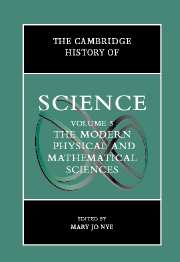Book contents
- Frontmatter
- Introduction: The Modern Physical and Mathematical Sciences
- Part I The Public Cultures of the Physical Sciences After 1800
- 1 Theories of Scientific Method
- 2 Intersections of Physical Science and Western Religion in the Nineteenth and Twentieth Centuries
- 3 A Twisted Tale: Women in the Physical Sciences in the Nineteenth and Twentieth Centuries
- 4 Scientists and Their Publics: Popularization of Science in the Nineteenth Century
- 5 Literature and the Modern Physical Sciences
- Part II Discipline Building in the Sciences: Places, Instruments, Communication
- Part III Chemistry and Physics: Problems Through the Early 1900s
- Part IV Atomic and Molecular Sciences in the Twentieth Century
- Part V Mathematics, Astronomy, and Cosmology Since the Eighteenth Century
- Part VI Problems and Promises at the End of the Twentieth Century
- Index
- References
4 - Scientists and Their Publics: Popularization of Science in the Nineteenth Century
from Part I - The Public Cultures of the Physical Sciences After 1800
Published online by Cambridge University Press: 28 March 2008
- Frontmatter
- Introduction: The Modern Physical and Mathematical Sciences
- Part I The Public Cultures of the Physical Sciences After 1800
- 1 Theories of Scientific Method
- 2 Intersections of Physical Science and Western Religion in the Nineteenth and Twentieth Centuries
- 3 A Twisted Tale: Women in the Physical Sciences in the Nineteenth and Twentieth Centuries
- 4 Scientists and Their Publics: Popularization of Science in the Nineteenth Century
- 5 Literature and the Modern Physical Sciences
- Part II Discipline Building in the Sciences: Places, Instruments, Communication
- Part III Chemistry and Physics: Problems Through the Early 1900s
- Part IV Atomic and Molecular Sciences in the Twentieth Century
- Part V Mathematics, Astronomy, and Cosmology Since the Eighteenth Century
- Part VI Problems and Promises at the End of the Twentieth Century
- Index
- References
Summary
In 1799 the Royal Institution was founded in London, in the wake of various provincial literary and philosophical societies; in 1851, under Prince Albert of Saxe-Coburg’s aegis, the Great Exhibition attracted vast crowds to London, yielding profits to buy land in South Kensington for colleges and museums; and in 1900 the Paris Exposition heralded a new century of scientific and technical progress. There were prominent critics, but the wonders of science proved throughout the nineteenth century to be attractive to audiences of the aristocracy and gentry, of working men, and of everybody in between – which was fortunate, because in this world of competing beliefs and interests, of markets and industrial capitalism, those engaged in science needed to arouse the enthusiasm of people who would support them. Popularization started in Europe but was taken up in the United States, in Canada and Australasia, in India and other colonies, and in Japan.
We shall focus upon Britain because of its place as the first industrial nation, where cheap books and publications emerged early, and scientific lectures were a feature of intellectual life. Specialization came relatively late to British education, so that until the end of the nineteenth century, university graduates shared to a great extent a common culture. Great Britain contained two nations, the English and the Scots, whose educational histories were very different; and Ireland was another story. Scotland had been, ever since its Calvinist Reformation, a country where education was valued and could be had cheaply in parochial schools and at the universities: It was throughout the eighteenth and nineteenth centuries an exporter of talent, to England, the Continent, and North America.
- Type
- Chapter
- Information
- The Cambridge History of Science , pp. 72 - 90Publisher: Cambridge University PressPrint publication year: 2002



